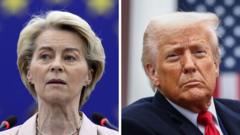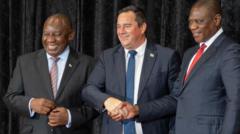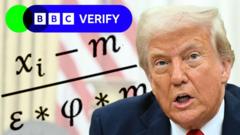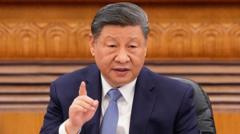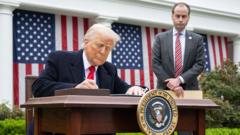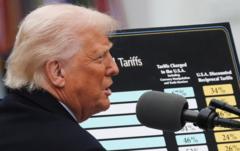President Trump announces an aggressive tariff plan, stirring controversy and potential global economic impacts.
**Trump Implements Tariffs Up to 50% on Key Trading Partners**
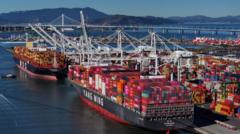
**Trump Implements Tariffs Up to 50% on Key Trading Partners**
New import taxes set to redefine US trade relations and economic landscape.
In a dramatic shift in US trade policy, President Donald Trump has announced a substantial increase in tariffs on international imports, marking a significant departure from decades of free trade principles. The proposed measures include a baseline tariff of 10% on all imports, effective April 5, with escalated rates targeting countries labeled as "worst offenders," including the European Union and China. Goods originating from these nations will face tariffs escalating up to 50%.
With an assertive declaration of a national emergency, Trump accused foreign nations of detrimental practices against US trade, claiming that the US has been "looted, pillaged, raped, and plundered." He framed the announcement as a declaration of economic independence for American workers, asserting it as a vital moment in US history. The administration’s stance is that this is a necessary response to long-standing imbalances that have favored foreign entities over American industry.
The more severe tariff measures indicate rates of up to 46% on imports from Vietnam and Cambodia, while nations like Japan and India will face tariffs of 24% and 26%, respectively. Notably, smaller countries such as Lesotho could see tariffs as high as 50%. The White House emphasized that this tariff structure is designed to address issues such as currency manipulation and high VAT rates implemented by other countries.
The move towards higher tariffs is anticipated to backfire economically, leading to increased consumer prices within the US and a slowdown in global growth, according to analysts. Historically, tariffs have prompted retaliatory actions, threatening a backlash against American exports and complicating relationships with key allies.
Critics of the policy, including economists and industry leaders, have voiced concerns about the long-term impacts on US businesses and consumers. Many predict that a significant hike in tariffs will burden American companies that depend on global supply chains, leading to potentially higher prices for everyday goods, including clothing and electronics.
Market responses were swift; shares in major companies, particularly those heavily reliant on international trade like Apple and Amazon, declined sharply following the announcement. As the financial ramifications unravel, the landscape of international trade appears poised for a substantial transformation, with experts asserting that the long-standing order established post-World War II is on the verge of unravelling.
As the implications of these tariffs unfold, stakeholders worldwide are watching closely, aware that the repercussions of these policies may reverberate far beyond US borders.
With an assertive declaration of a national emergency, Trump accused foreign nations of detrimental practices against US trade, claiming that the US has been "looted, pillaged, raped, and plundered." He framed the announcement as a declaration of economic independence for American workers, asserting it as a vital moment in US history. The administration’s stance is that this is a necessary response to long-standing imbalances that have favored foreign entities over American industry.
The more severe tariff measures indicate rates of up to 46% on imports from Vietnam and Cambodia, while nations like Japan and India will face tariffs of 24% and 26%, respectively. Notably, smaller countries such as Lesotho could see tariffs as high as 50%. The White House emphasized that this tariff structure is designed to address issues such as currency manipulation and high VAT rates implemented by other countries.
The move towards higher tariffs is anticipated to backfire economically, leading to increased consumer prices within the US and a slowdown in global growth, according to analysts. Historically, tariffs have prompted retaliatory actions, threatening a backlash against American exports and complicating relationships with key allies.
Critics of the policy, including economists and industry leaders, have voiced concerns about the long-term impacts on US businesses and consumers. Many predict that a significant hike in tariffs will burden American companies that depend on global supply chains, leading to potentially higher prices for everyday goods, including clothing and electronics.
Market responses were swift; shares in major companies, particularly those heavily reliant on international trade like Apple and Amazon, declined sharply following the announcement. As the financial ramifications unravel, the landscape of international trade appears poised for a substantial transformation, with experts asserting that the long-standing order established post-World War II is on the verge of unravelling.
As the implications of these tariffs unfold, stakeholders worldwide are watching closely, aware that the repercussions of these policies may reverberate far beyond US borders.

